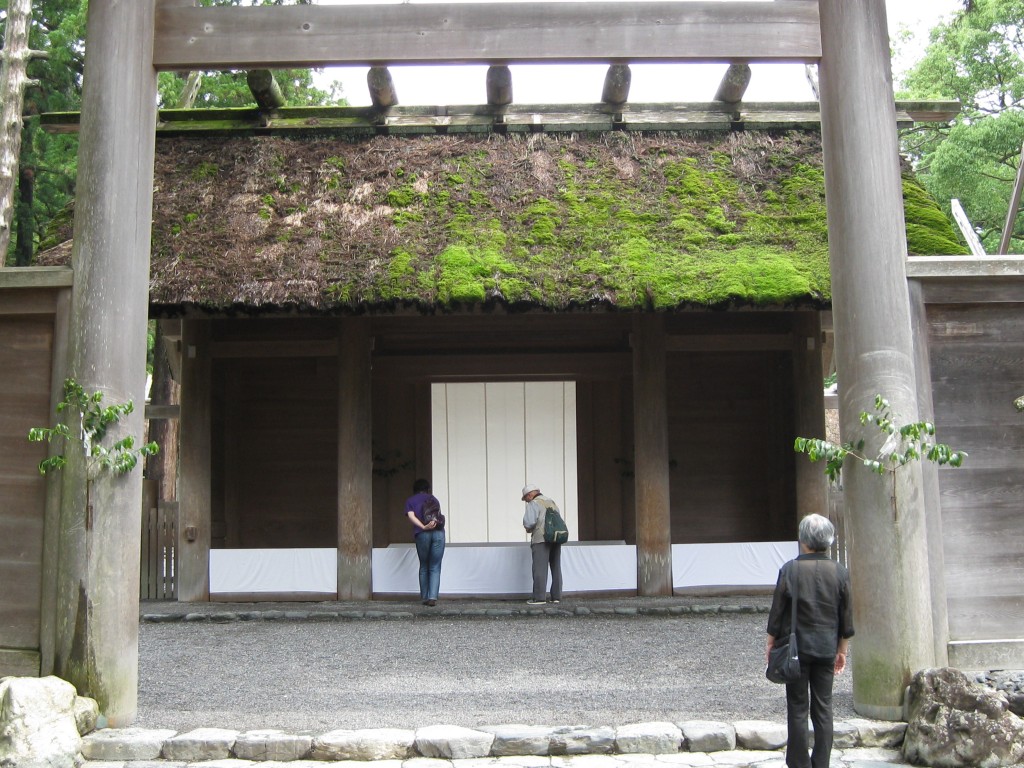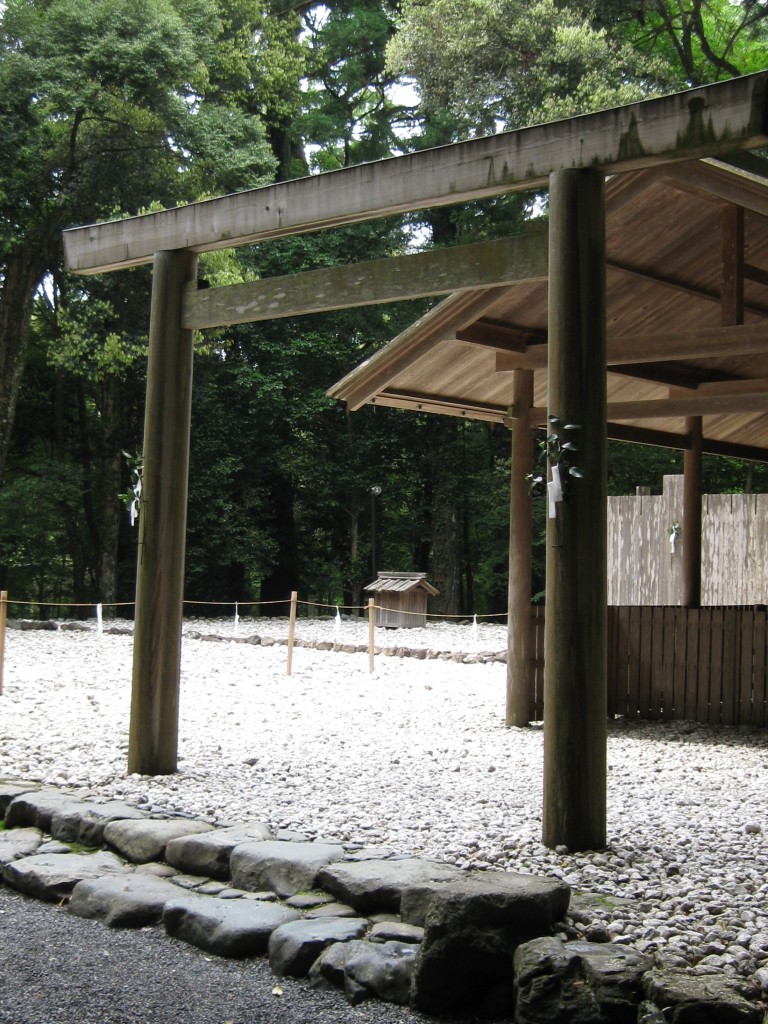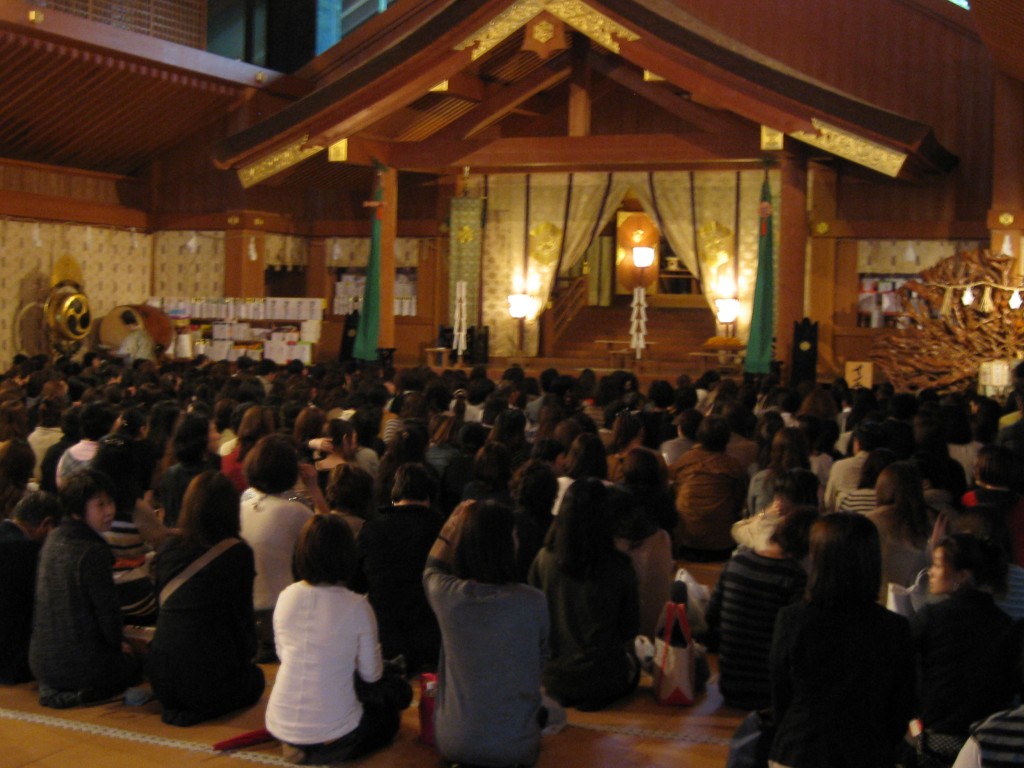
Outer gate at Naiku, one of the more than 100 buildings that are being renewed at Ise jingu
2013 is going to be the year of the Shikinen Sengu (rebuilding) at the country’s premier shrines of Ise and Izumo. By coincidence, both major shrines are due to complete their rebuilding this year amidst rites and celebrations. My local shrine of Shimogamo here in Kyoto is due to complete its renewal also. Only ten shrines around the country still carry out the ancient practice apparently. What a year it will be….
“Everybody storms to Ise Jingu in reverence for the Shikinen Sengu Ceremony.” – Matsuo Basho
But what on earth is it? Here’s an explanation, courtesy of the Shimane website….

A shrine building at Ise with the allotted space next to it for the rebuilding
Sengu
The term sengu is used any time work is done on a shrine building, from simple roof repairs to a complete rebuilding of the shrine, or even a relocation of the shrine building. While work is being done on a shrine, the deity is moved to a temporary shrine. Then, once all work is finished, the deity is returned to the repaired, rebuilt, or relocated shrine. This is because a shrine is considered to be a holy place, and things like people standing on a shrine roof to work or noisy construction are thought to be offensive to the gods.
Practically, sengu are done for shrine upkeep, but there is a spiritual aspect to sengu as well. By making the shrine new again, a sengu symbolizes a renewal of power and vitality for the deity of that shrine. The most well-known example of a sengu is that of Ise Grand Shrine in Mie Prefecture, where all the shrine buildings on the ground are completely rebuilt every 20 years.
While most shrines only have a sengu when work is absolutely necessary, Izumo Taisha is one of the other few examples of a sengu being held on a regular schedule. Izumo Taisha’s sengu, however, is held every 60 years. At 24 meters tall, Izumo Taisha’s main hall is the tallest of its kind in Japan, and a complete reconstruction at its current size is infeasible. There are no longer any trees left in Japan of the height and width necessary to build a 24-meter high shrine building. So to preserve the current main hall as long as possible, Izumo Taisha’s main hall is reroofed every 60 years.
The current main hall was built in 1744, and has been designated as a national treasure. The roof of the shrine, which is made of bark from Japanese cypress trees (hinoki), is totally exposed to the elements.
After 60 years, the wind, rain, snow, and sun take their toll on the roof. Birds also pull out pieces of bark to make their nests in the roof, and large patches of moss grow near the eaves.
60 years is considered to be the general limit for a cypress bark roof to last, so it is removed, and any other necessary repairs on the building structure are performed. This is no small task. The thin strips of cypress bark that make up the roof are almost a meter thick in places, and it takes over 640,000 strips of bark, weighing nearly 47 tons, to roof the entire shrine.
The current sengu started in 2008 and is scheduled to finish in 2013, the same year as the sengu for Ise Grand Shrine will be completed.
*****************************************************
There’s an explanation of the Ise sengu here. For a list of the asscociated ceremonies culminating in October, see here.

Inside one of the Izumo Taisha buildings... Imagine having to rebuild the whole of that, roof and all...

I haven’t been able to find actual dates for the Ise sengu only October 2013…do you happen to know when in October?
Hi there…
I’m afraid I can’t see any firm dates for the October events, so all I can do is contact the Ise Jingu directly… Or how about trying the The Isejingu-Sukeikai Foundation (Ise Jingu Worshipers’ Foundation)…
Fax: +81-596-22-1517
Homepage http://www.jingukaikan.net/
i-mode http://www.jingukaikan.net/i/
I’m considering going to the Naiku this summer. Will visitors be more restricted than normal in what they can see? Is it best to wait until 2014?
Hello Laura… I haven’t heard of any restrictions, and I would expect that unless the visit coincides with a special ceremony of some kind you should have no problems… I hope you’ll let us know about your visit afterwards…
Thanks, John. I’ve also called the NYC office of the JNT. They are kindly working on a phone call to the Ise branch to ask if there are any restrictions. Apparently many people are wondering. I will be excited to visit and will gladly share my experiences. I first learned about the Ise Jingu 19 years ago, have been many times since then, but promised myself I would go during the sengu. It’s been an incredibly powerful and symbolic place for me over the years.
Best, Laura
http://www.laurakaufmanstudio.com